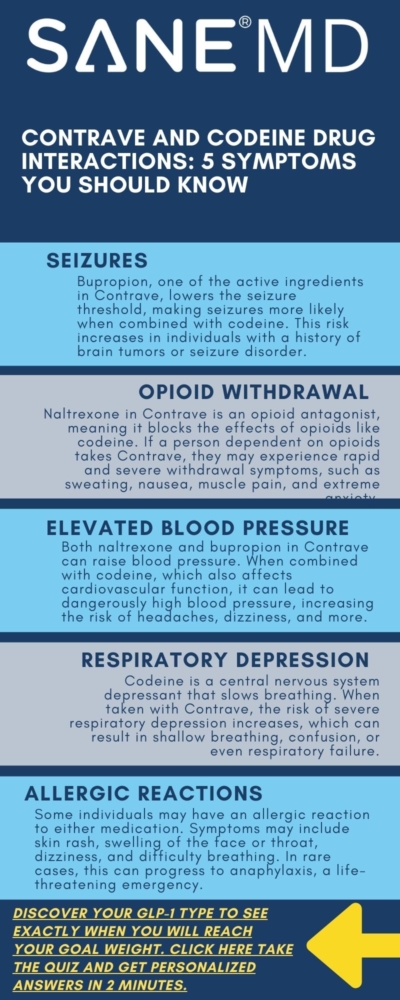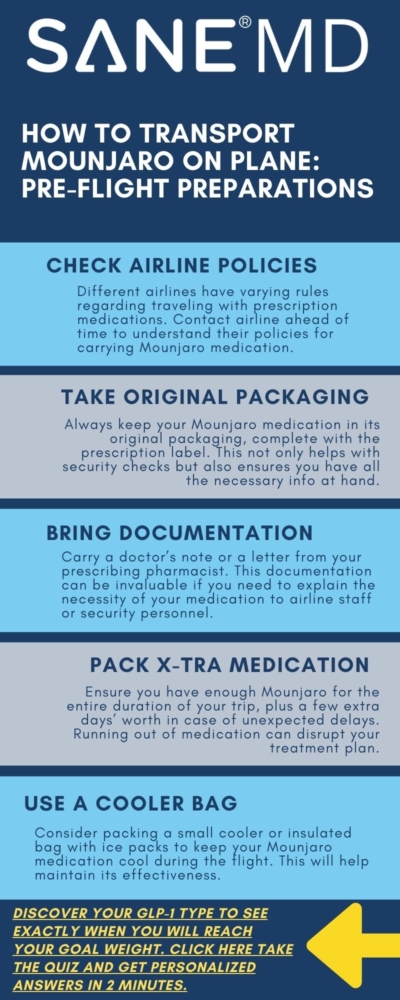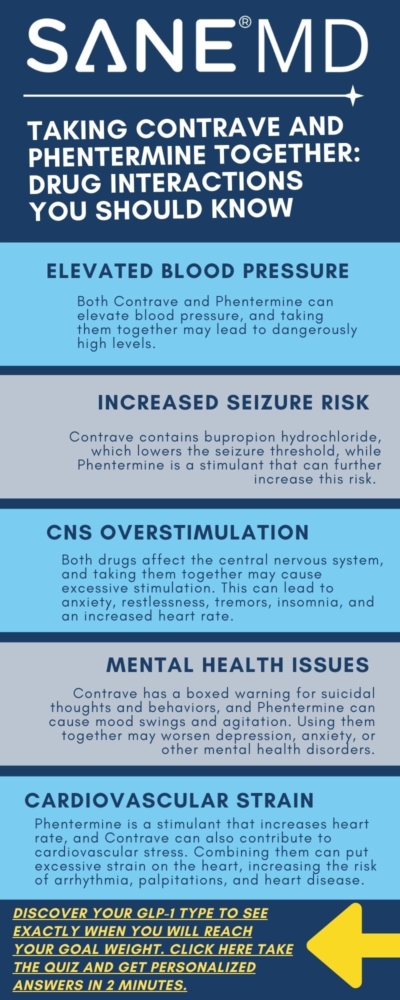Contrave and Codeine Drug Interactions: Risks & Warnings

Combining medications can lead to unexpected and potentially dangerous interactions, particularly when they affect the central nervous system, cardiovascular function, or metabolic processes. This is especially true for Contrave and codeine drug interactions, which pose significant health risks due to their opposing mechanisms of action.
Contrave, a prescription medication used for chronic weight management for compatible individuals, contains naltrexone and bupropion, both of which can impact neurotransmitter activity and opioid receptors. Codeine, an opioid analgesic, is commonly prescribed for pain relief and cough suppression, but it also has sedative effects and carries the potential for physical dependence and respiratory depression.
When taken together, these medications can interact in ways that may lead to serious adverse reactions, including an increased risk of seizures, precipitated opioid withdrawal symptoms, and elevated blood pressure. Understanding these interactions is crucial for patients and healthcare providers to prevent potentially life-threatening complications. So, is Contrave the right fit for your weight loss journey?
This article will explore the effects of Contrave and codeine drug interactions, detailing the risks, symptoms, and necessary precautions to ensure safe medication use.
Key Takeaways
- Increased Risk of Seizures: Combining Contrave with codeine may elevate the risk of seizures due to bupropion’s effect on the seizure threshold.
- Potential for Opioid Withdrawal: Naltrexone in Contrave can precipitate withdrawal symptoms in individuals dependent on opioids like codeine.
- Elevated Blood Pressure: The combination may lead to increased blood pressure, necessitating careful monitoring.
What Is Contrave?
Contrave is a prescription medication combining two active ingredients: naltrexone and bupropion. It is primarily used for chronic weight management in certain adults with a body mass index (BMI) of 30 kg/m² or greater (obese) or 27 kg/m² or greater (overweight) with at least one weight-related condition, such as high blood pressure or type 2 diabetes.
Contrave is intended to be used alongside a reduced-calorie diet and increased physical activity.
- Naltrexone: An opioid antagonist that blocks the effects of opioids in the brain.
- Bupropion: A norepinephrine-dopamine reuptake inhibitor commonly used to treat depression and assist with smoking cessation.
Together, these components influence the central nervous system to reduce appetite and control cravings, aiding in weight loss efforts.
What Is Codeine?
Codeine is an opioid analgesic used to treat mild to moderately severe pain and to reduce coughing. It works by converting to morphine in the body, binding to opioid receptors in the brain to decrease the perception of pain and suppress cough reflexes.
As an opioid, codeine carries risks of physical dependence, respiratory depression, and potential for misuse. It is metabolized in the liver by the enzyme CYP2D6 into its active form, morphine.
Key Risks of Contrave and Codeine Interactions
| Risk | Description |
|---|---|
| Seizures | Bupropion in Contrave lowers the seizure threshold, increasing seizure risk when combined with codeine. |
| Opioid Withdrawal | Naltrexone in Contrave blocks opioid receptors, triggering withdrawal symptoms in opioid-dependent individuals. |
| Elevated Blood Pressure | Both Contrave and codeine can raise blood pressure, posing a risk for individuals with hypertension. |
| Respiratory Depression | Codeine can slow breathing, and combining it with Contrave increases the risk of respiratory failure. |
| Allergic Reactions | Combining these drugs may increase the risk of allergic reactions, including rash, swelling, and breathing difficulties. |
Dangers of Combining Contrave and Codeine
Using Contrave and codeine together can lead to several adverse reactions due to their pharmacological interactions:
Risk of Seizures
Bupropion, a component of Contrave, is known to lower the seizure threshold, increasing the likelihood of seizures. Combining bupropion with other drugs that also lower the seizure threshold or with substances that affect the central nervous system can further increase the risk of seizures.
Therefore, concurrent use of Contrave and codeine may elevate this risk.
Opioid Withdrawal Symptoms
Naltrexone in Contrave is an opioid antagonist that blocks opioid receptors. In individuals who regularly use opioids like codeine, naltrexone can precipitate opioid withdrawal symptoms.
These symptoms may occur rapidly and can be severe, including agitation, nausea, vomiting, sweating, and abdominal cramps.
Increased Blood Pressure
Contrave has been associated with increases in blood pressure and heart rate. Combining it with codeine, which can also affect cardiovascular function, may lead to further elevations in blood pressure. Additionally, Contrave and Metoprolol drug interactions can pose similar cardiovascular risks, particularly for individuals managing hypertension with beta-blockers.
This is particularly concerning for individuals with pre-existing high blood pressure or other cardiovascular conditions.
Symptoms of Interaction
When Contrave and codeine are taken together, several symptoms may manifest due to their pharmacological interactions. These symptoms can range from mild discomfort to severe, life-threatening conditions. Understanding these potential effects is crucial for patients taking bupropion and opioids, as some interactions may require immediate medical intervention.
Each symptom is outlined below in detail:
Seizures
The combination of bupropion in Contrave and codeine may significantly lower the seizure threshold, increasing the seizure risk.
Bupropion naltrexone is known to have pro-convulsant properties, which can increase the risk of seizures, especially in individuals with seizure disorders or other risk factors, such as a history of brain tumors or eating disorders.
Symptoms of seizures may include:
- Convulsions or involuntary muscle contractions
- Loss of consciousness
- Sudden confusion or disorientation
- Uncontrolled jerking movements
- Aura (sensory disturbances before a seizure)
People taking other drugs that lower the seizure threshold, such as tricyclic antidepressants, may face an increased risk when using Contrave and codeine together.
Opioid Withdrawal Symptoms
Because naltrexone is an opioid antagonist, it blocks the effects of opioids like codeine. For individuals who have opioid dependence, Contrave can trigger opioid withdrawal symptoms, which may occur suddenly and may be severe.
Patients treated with opioids for chronic pain or opioid withdrawal management should avoid taking Contrave, as the combination can result in rapid and life-threatening withdrawal effects.
Symptoms of opioid withdrawal may include:
- Extreme anxiety or restlessness
- Muscle aches and joint pain
- Profuse sweating and chills
- Nausea, vomiting, or diarrhea
- Abdominal cramps
- Tremors or shaking
- Rapid heart rate and high blood pressure
In severe cases, withdrawal symptoms can lead to cardiovascular complications, including severely high blood pressure or heart arrhythmias.
Elevated Blood Pressure
Both bupropion and naltrexone in Contrave have been linked to increased blood pressure, which can be further exacerbated by codeine’s effects on the cardiovascular system.
Patients with high blood pressure or those taking medications to regulate blood pressure should be especially cautious.
Signs of elevated blood pressure may include:
- Persistent headaches
- Dizziness or feeling lightheaded
- Blurred vision
- Shortness of breath
- Nosebleeds
- Chest pain in severe cases
A dosage adjustment or close monitoring of blood pressure may be required when taking naltrexone bupropion alongside other medications that impact cardiovascular function.
Respiratory Depression
Codeine is a central nervous system depressant that can slow down breathing. When combined with Contrave, especially in individuals with pre-existing respiratory conditions, there is an increased risk of severe respiratory depression, which may occur suddenly.
This risk is even higher for individuals taking other medications that suppress respiration, such as benzodiazepines.
Symptoms of respiratory depression may include:
- Slow or shallow breathing
- Difficulty breathing or gasping for air
- Extreme drowsiness or unresponsiveness
- Blue tint to lips or fingernails (cyanosis)
- Confusion or mental fog
If respiratory depression progresses, it can lead to coma or even death, requiring immediate emergency medical attention.
Allergic Reactions
Taking Contrave and codeine together may increase the risk of an allergic reaction, especially in individuals with hypersensitivity to either medication.
A serious allergic reaction could lead to anaphylaxis, a life-threatening emergency that requires immediate medical intervention.
Symptoms of an allergic reaction may include:
- Skin rash, redness, or itching
- Swelling of the face, lips, or throat
- Severe dizziness or fainting
- Difficulty breathing or wheezing
Patients with a history of serious allergic reaction to bupropion, naltrexone, or opioids should not take Contrave and codeine together due to the heightened risk of anaphylaxis.
Other Potential Symptoms
In addition to the major interactions listed above, some patients treated with Contrave and codeine may experience adverse reactions, including:
- Low blood sugar (hypoglycemia): Patients with diabetes using naltrexone bupropion should monitor blood sugar levels closely.
- Unusual tiredness or fatigue: This may occur due to central nervous system effects.
- Skin rash or hives: A sign of an allergic reaction or adverse reactions to the drug combination.
- Mental health changes: Suicidal thoughts or mood instability may occur, especially in those with bipolar disorder or other mental health conditions.
Given these risks, it is crucial to monitor patients using Contrave and codeine closely and report any serious symptoms to a healthcare provider immediately.
Precautions and Recommendations
When taking prescription medications, especially those with significant drug interactions, following proper precautions is essential to prevent adverse effects.
Since Contrave and codeine can interact in ways that increase health risks, individuals should take the following measures to ensure safe and effective treatment.

Consult Healthcare Providers
Before starting or stopping any medication, including over-the-counter drugs, it is crucial to consult a healthcare provider to assess potential interactions.
- Why this is important: Some drug interactions may increase the risk of severe complications, including seizures, opioid withdrawal symptoms, and respiratory depression.
- Who should be extra cautious? Individuals with pre-existing health conditions, those taking multiple medications, or those with a history of opioid dependence or seizure disorders.
- What to discuss with a provider:
- Current medications, including prescription drugs, over-the-counter treatments, and supplements.
- Any history of mental health conditions, high blood pressure, or seizure risk.
- Past allergic reactions to medications, including bupropion naltrexone or opioids.
Avoid Concurrent Use
Due to the significant risks, concurrent use of Contrave and codeine is generally not recommended.
- Why this is important: The combination can lead to severe effects such as opioid withdrawal symptoms, elevated blood pressure, and respiratory depression.
- Who is at the highest risk?
- Patients with opioid dependence: Naltrexone bupropion in Contrave blocks opioid receptors, leading to precipitated withdrawal if opioids are in the system.
- Patients with a seizure disorder: Bupropion lowers the seizure threshold, making seizures more likely.
- Those with high blood pressure: Contrave can increase blood pressure, and codeine may further alter cardiovascular function.
- Alternatives to consider:
- If pain management is necessary, discuss alternative medications with a healthcare provider.
- If weight loss medications are needed, explore different weight loss options that do not interact with opioids.
Monitor Health Conditions
Individuals with pre-existing conditions such as seizure disorders, high blood pressure, or bipolar disorder should be closely monitored when taking naltrexone bupropion.
- Seizure Disorders: Since bupropion lowers the seizure threshold, individuals with a history of brain tumors, eating disorders, or other neurological conditions should use extreme caution. Seizure risk may also increase the risk of severe complications.
- High Blood Pressure: Naltrexone bupropion can raise blood pressure, particularly in individuals with hypertension. Severely high blood pressure may develop, requiring dose adjustment or discontinuation.
- Bipolar Disorder & Mental Health Conditions: Since bupropion affects the serotonergic neurotransmitter system, patients with major depressive disorder or mental health conditions should be monitored for suicidal thoughts, mood changes, or increased mental health symptoms.
Be Aware of Other Medications
It is essential to inform healthcare providers about all medications being taken, including over-the-counter drugs, herbal supplements, and prescription medications.
- Why this is important:
- Other drugs may increase the risk of interactions, such as tricyclic antidepressants, systemic corticosteroids, or monoamine oxidase inhibitors.
- Opioid withdrawal symptoms may occur if an opioid antagonist like naltrexone is introduced into the system while taking opioid painkillers.
- Serotonin syndrome occurs when drugs affecting serotonin levels, such as certain antidepressants, are combined.
- Medications to discuss with your doctor:
- Antidepressants (tricyclic antidepressants, SSRIs, MAOIs). When taking Prozac and Contrave together, drug interactions can occur.
- Blood pressure medications
- Other weight loss medications
- Pain relievers, including opioids and NSAIDs
- Over-the-counter drugs and herbal supplements
See our complete guide on Contrave drug interactions for more information.
Follow Prescribed Dosages
Adhering to prescribed dosages and schedules is essential for reducing the risk of adverse reactions.
- Do not increase or decrease the dosage of Contrave or codeine without consulting a healthcare provider. Dosage adjustment may be required for individuals with severe hepatic impairment or other health conditions.
- Avoid high-fat meals when taking extended-release tablets of Contrave, as they can increase the systemic exposure of the drug, raising the likelihood of side effects.
- Do not suddenly stop drinking alcohol only under medical supervision, as alcohol withdrawal may increase the risk of seizures when taking both bupropion and opioids.
- Doctors should monitor patients for symptoms of serotonin syndrome, unusual tiredness, or serious allergic reaction while taking these medications.
Frequently Asked Questions (FAQ)
Understanding potential drug interactions is essential to maintaining safe and effective treatment when taking Contrave, codeine, or other prescription medications.
Below are answers to common questions regarding the use of Contrave, codeine, and pain medications, ensuring you have the information needed to avoid serious health risks.
1. Can you take bupropion and codeine together?
Taking bupropion and codeine together is generally not recommended due to potential drug interactions. Bupropion, one of the active ingredients in Contrave, can lower the seizure threshold, increasing the risk of seizures when combined with codeine.
Additionally, bupropion affects liver enzymes that metabolize codeine, potentially altering its effectiveness or leading to unexpected side effects. If you need pain relief while taking Contrave, consult a healthcare provider for safer alternatives.
2. Can you take opioids with Contrave?
Opioids should not be taken with Contrave due to the presence of naltrexone, which is an opioid antagonist. Naltrexone blocks opioid receptors, preventing opioids like codeine, hydrocodone, or oxycodone from working properly. If an individual dependent on opioids takes Contrave, they may experience severe opioid withdrawal symptoms, including nausea, vomiting, sweating, muscle pain, and extreme discomfort.
If you require pain management, speak with a healthcare provider about alternative pain relief options that are compatible with Contrave.
3. What medications should I avoid with Contrave?
Several medications should be avoided while taking Contrave due to potential interactions that may cause serious side effects. Opioids should be avoided since naltrexone can block their effects and trigger withdrawal symptoms. Other medications that may interact with Contrave include antidepressants, monoamine oxidase inhibitors (MAOIs), tricyclic antidepressants, and medicines that affect serotonin levels, as they may increase the risk of serotonin syndrome.
Additionally, high-fat meals should be avoided when taking extended-release Contrave tablets, as they can increase drug absorption and the risk of side effects, such as Contrave constipation. Always discuss your full medication list with a healthcare provider before starting Contrave.
4. What pain medicine can I take with Contrave?
Since opioids cannot be taken with Contrave, patients should consider non-opioid pain relief options. Acetaminophen (Tylenol) is generally considered safe and can be used for mild to moderate pain relief. Nonsteroidal anti-inflammatory drugs (NSAIDs) such as ibuprofen (Advil, Motrin) and naproxen (Aleve) may also be suitable. Still, they should be used with caution, especially in individuals with high blood pressure or cardiovascular conditions.
Before using any pain medication, consult with a healthcare provider to ensure it is safe and appropriate for your specific health conditions.
5. Can you take painkillers with Contrave?
Certain painkillers can be taken with Contrave, but opioid-based painkillers should be avoided. Opioids, such as codeine, oxycodone, or hydrocodone, interact with naltrexone, potentially leading to opioid withdrawal symptoms or reduced pain relief effectiveness.
However, over-the-counter painkillers such as acetaminophen, ibuprofen, and naproxen are generally considered safer options. Always check with your doctor before taking any painkillers while using Contrave to avoid adverse reactions or unintended drug interactions.
Final Considerations
Since Contrave and codeine drug interactions can lead to life-threatening complications, patients treated with these medications should follow strict medical supervision.
Understanding the potential risks, including increased risk of seizures, opioid withdrawal, and elevated blood pressure, is key to ensuring safe treatment initiation and successful weight loss without compromising overall health.
In summary, the combination of Contrave and codeine presents significant health risks, including seizures, opioid withdrawal, elevated blood pressure, and respiratory depression. It is crucial to consult healthcare providers before combining these medications to ensure safe and effective treatment.

How to Transport Mounjaro on Plane: A Comprehensive Guide

Traveling with medication can feel overwhelming, especially when it involves temperature-sensitive medications like Mounjaro. Temperature control is a critical aspect of traveling with Mounjaro to ensure its effectiveness. Whether you’re taking Mounjaro for weight loss or managing a health condition, knowing how to transport Mounjaro on plane is essential to ensure it stays effective during your trip.
This guide covers everything you need to know about traveling with Mounjaro, from packing it in your carry-on luggage to maintaining the right temperature.
Let’s dive into the details to make your journey smooth and stress-free.
Key Takeaways
- Proper Storage is Essential—For optimal effectiveness, Mounjaro must be kept between 36°F and 46°F (2°C to 8°C), but it can stay at room temperature (up to 86°F or 30°C) for up to 21 days if necessary. Using an insulated travel case with ice packs helps maintain the right temperature during flights.
- Pack Smart for Air Travel: Always carry Mounjaro in your carry-on luggage, keep it in its original packaging with the prescription label, and bring a doctor’s note if possible. The TSA allows injectable medications, but security screenings may require additional documentation or explanation.
- Plan for Security and Customs – Be prepared to declare your medication, explain your cooler bag or ice packs, and check airline and destination country regulations regarding prescription medications. Carrying extra doses can help prevent treatment disruptions in case of delays.
Understanding Mounjaro and Its Storage Needs
Mounjaro, developed by Eli Lilly, is a prescription medication delivered through weekly injections using Mounjaro pens. It’s one of the popular weight loss medications that requires careful handling due to its storage requirements. If you’re considering using Mounjaro, you may also want to explore its safety profile. Our guide on Is Mounjaro Safe? provides essential insights into its benefits, risks, and potential side effects.
The active ingredient in Mounjaro medication is sensitive to temperature, meaning it must be kept refrigerated between 36°F and 46°F (2°C to 8°C) for optimal effectiveness. Temperature control is crucial in ensuring the medication’s effectiveness. However, it can also remain at room temperature—up to 86°F (30°C)—for a limited time, which is useful for travel plans.
Properly storing Mounjaro ensures the medication remains effective for your treatment. Exposing Mounjaro pens to extreme heat, direct sunlight, or freezing conditions can compromise their quality. So, when planning to travel with Mounjaro, preparation is key.
Mounjaro Airline Travel Guide: Key Considerations
| Category | Details |
|---|---|
| Storage Requirements | Keep Mounjaro refrigerated at 36°F to 46°F (2°C to 8°C); can remain at room temperature (up to 86°F or 30°C) for up to 21 days if necessary. |
| Packing Guidelines | Pack in carry-on luggage, use original packaging with prescription label, carry a doctor’s note, and store in an insulated travel case with ice packs. |
| Security Screening | TSA allows prescription injectable medications, but additional screening may be required. Keep documentation handy and request a manual inspection if needed. |
| Temperature Control | Use an insulated bag with ice packs, avoid direct sunlight or freezing, and monitor the temperature during travel. |
| Travel Tips | Check airline and destination country regulations, carry extra doses in case of delays, store properly at your destination, and avoid exposing Mounjaro to extreme temperatures. |
Pre-Flight Preparations
Before embarking on your journey with Mounjaro, a few pre-flight preparations can ensure a smooth and safe trip.
Here’s what you need to do:
- Check Airline Policies: Different airlines have varying rules regarding traveling with prescription medications. Contact your airline ahead of time to understand their specific policies for carrying Mounjaro medication.
- Pack Original Packaging: Always keep your Mounjaro medication in its original packaging, complete with the prescription label. This not only helps with security checks but also ensures you have all the necessary information at hand.
- Bring Documentation: Carry a doctor’s note or a letter from your prescribing pharmacist. This documentation can be invaluable if you need to explain the necessity of your medication to airline staff or security personnel.
- Pack Extra Medication: Ensure you have enough Mounjaro for the entire duration of your trip, plus a few extra days’ worth in case of unexpected delays. Running out of medication can disrupt your treatment plan.
- Use a Cooler Bag: Consider packing a small cooler or insulated bag with ice packs to keep your Mounjaro medication cool during the flight. This will help maintain its effectiveness.
- Consult Your Doctor: If you have any specific concerns or questions about traveling with Mounjaro, consult your doctor or pharmacist before your trip. They can provide personalized advice and additional tips.
By taking these steps, you can ensure that your Mounjaro medication remains effective and that you’re prepared for any situation that might arise during your travels.
How Do You Fly with Mounjaro?
Flying with Mounjaro is relatively easy if you follow a few guidelines. Always pack your Mounjaro pens in your carry-on luggage rather than checked luggage. This keeps the medication under your control and protects it from temperature fluctuations in the cargo hold. Airport security allows passengers to bring prescription medication through security checks, but you’ll need to follow some basic rules, including security screening procedures.
Keep your Mounjaro pens in their original packaging, with the prescription label clearly visible. This helps TSA agents verify that they are legitimate medications. You don’t need to declare them unless asked, but having your doctor’s note or a copy of your prescription handy can help if questions arise.
For added protection, store the pens in a cool bag with an ice pack to maintain the right temperature during your flight.
Packing Mounjaro Pens for Your Trip
When preparing to travel with Mounjaro, your carry-on bag is your best friend.
Here’s a step-by-step guide to packing:
- Use Original Packaging: Keep Mounjaro pens in their original boxes to show they’re prescription medication.
- Add a Cool Bag: To keep Mounjaro cool, place the pens in an insulated travel case, container, or cool bag with an ice pack.
- Avoid Freezing: Ensure the ice pack doesn’t freeze Mounjaro—direct contact with ice can damage the medication.
- Protect from Light: Store the cool bag in a spot away from direct sunlight to maintain effectiveness.
- Secure the Pen Cap: Make sure each Mounjaro pen has its cap on to prevent leaks or damage.
By keeping Mounjaro in your hand luggage, you can monitor its condition throughout the trip. Avoid placing it in checked luggage, where temperatures can drop below fridge levels or soar above 86°F (30°C).
Packing Mounjaro in Carry-On Luggage
When it comes to packing Mounjaro in your carry-on luggage, following these guidelines will help ensure the medication remains effective throughout your journey:
- Use a Clear Plastic Bag: Place your Mounjaro medication in a clear plastic bag. This will make it easier for security personnel to inspect it without having to handle the medication directly.
- Keep Original Packaging: Always keep the Mounjaro pens in their original packaging, with the pen cap attached. This protects the pens from direct sunlight and temperature fluctuations, ensuring the medication remains effective.
- Insulated Storage: Store the Mounjaro medication in a cool bag or insulated container with ice packs. This helps maintain fridge temperature, which is crucial for temperature-sensitive medications like Mounjaro.
- Carry-On Only: Always keep the Mounjaro medication in your carry-on luggage. Avoid placing it in checked luggage, as the cargo hold can expose it to extreme temperatures that could compromise its effectiveness.
- Portable Cooler: Consider investing in a small, portable cooler or insulated bag specifically designed for storing temperature-sensitive medications. This can provide an extra layer of protection during your flight.
By following these steps, you can ensure that your Mounjaro medication remains at the optimal temperature and is protected from any potential damage during your travels.

How to Take Injectable Medication on a Plane
Similar rules apply to Taking Mounjaro or other injectable medications on a plane. The TSA permits injectable prescription medications, including Mounjaro pens for weekly injections, in carry-on luggage, but you must be prepared for security screening as part of the process.
You can bring enough medication for your trip, plus a little extra in case of delays. If your trip is longer than expected, consult your healthcare provider about sourcing more at your destination country.
During security checks, place your Mounjaro pens in a clear plastic bag for easy inspection. X-rays used at airport security won’t harm the medication, so there’s no need to worry. However, if you’re concerned, you can request a manual inspection instead.
Temperature Control: Keeping Mounjaro Cool
Mounjaro is a temperature-sensitive medication, so maintaining the right temperature is critical. Ideally, Mounjaro refrigerated at fridge temperature (36°F to 46°F) is the gold standard. But when you’re on the move, a cool bag with an ice pack or an insulated container can keep the medication cool for hours. Just ensure the temperature doesn’t drop too low—never freeze Mounjaro, as it can ruin the active ingredient.
If you’re taking Mounjaro on a short flight, room temperature up to 86°F (30°C) is fine for a limited period. For longer trips, invest in travel cases designed for refrigerated medications. These insulated options help protect your Mounjaro dose from temperature fluctuations.
How Long Can Mounjaro Be Unrefrigerated?
One common question is how long Mounjaro pens can stay unrefrigerated. Temperature control is a key factor in determining this, and according to storage requirements, Mounjaro can be kept at room temperature (up to 86°F or 30°C) for up to 21 days without losing effectiveness.
This makes traveling with Mounjaro manageable, even if you don’t have immediate access to a fridge. However, avoid exposing it to direct sunlight or heat sources like a hot car, as this could shorten its shelf life.
Once your trip ends, store any unused Mounjaro pens in a refrigerator as soon as possible. Check the expiration date to ensure they’re still good to use for your treatment.
Security Screening and Customs
Navigating security screening and customs with Mounjaro medication can be straightforward if you’re well-prepared. Here’s how to make the process as smooth as possible:
- Declare Your Medication: When you reach airport security checkpoints, declare your Mounjaro medication. Be prepared to provide documentation, such as a prescription label or a doctor’s note, to verify the legitimacy of your medication.
- Original Packaging: Keep your Mounjaro medication in its original packaging, with the prescription label attached. This facilitates security screening and helps avoid any misunderstandings.
- Explain Your Cooler Bag: If you’re carrying a cool bag or insulated container with ice packs, be ready to explain its contents and purpose to security personnel. This can help expedite the screening process.
- Know Destination Regulations: Be aware of any specific regulations or restrictions on traveling with prescription medications, including Mounjaro, in your destination country. Some countries have strict rules, so it’s best to check in advance.
- Carry Documentation: Consider carrying a copy of your prescription and a letter from your doctor or pharmacist explaining your medical condition and the need for Mounjaro medication. This can be particularly useful if you encounter any issues at customs.
By being prepared and following these guidelines, you can easily navigate security screening and customs, ensuring that your Mounjaro medication remains safe and effective throughout your journey.
How to Travel with Weight Loss Injections
Traveling with weight loss medications like Mounjaro requires extra care, especially since they’re often refrigerated. Beyond weight loss, Mounjaro is used for other medical purposes as well. Our guide on What Is Mounjaro Used For? explores its full range of applications. Whether you’re managing weight loss or another condition, the process is the same: keep Mounjaro in your cabin luggage, use a cool bag or an insulated container, and protect it from extreme temperatures. Weight loss injections like Mounjaro pens are easy to transport if you plan ahead.
Talk to your doctor about your travel plans and ensure you have enough medication for the trip. Some destinations may have restrictions on certain medications, so check the rules of your destination country beforehand. If necessary, bringing your prescription label and a note from your healthcare provider can also help with customs.
Travel Tips for Storing Mounjaro
Here are some practical travel tips to keep Mounjaro safe:
- Use a Cool Bag: Invest in a high-quality cool bag, insulated travel case, or insulated container to maintain temperature.
- Monitor Temperature: Avoid leaving Mounjaro in a car where heat or cold can affect it.
- Pack Extra Ice Packs: Bring spares to keep the medication cool during long flights or layovers.
- Store Properly at Your Destination: Find a fridge to store Mounjaro once you arrive.
- Avoid Direct Sunlight: Keep the pens out of light to protect their potency.
These steps ensure your Mounjaro medication stays effective throughout your journey.
What to Do at Your Destination
Once you arrive, it is just as important to store Mounjaro properly. If your hotel has a fridge, use it to keep Mounjaro refrigerated. However, refrigerators vary in temperature, so avoid placing the pens too close to the freezer compartment.
If no fridge is available, keep them in a cool bag with an ice pack or an insulated container, ensuring they stay below 86°F (30°C).
For longer trips, check with your doctor about how to maintain your treatment schedule. Taking Mounjaro on the same day each week helps avoid more side effects and keeps your weight loss progress on track.
Additional Considerations for Safe Travels
Before you travel with Mounjaro, double-check a few things:
- Medical Insurance: Ensure your policy covers medication refills abroad if needed.
- Original Packaging: Always carry Mounjaro pens in their boxes for proof of legitimacy.
- Doctor’s Advice: Consult your doctor for personalized travel tips.
- Security Screening: Be prepared for airport security screening. Know what to expect, and have your medication documentation ready.
- Luggage Space: Reserve room in your hand luggage for your medication and travel cases.
By preparing ahead, you can enjoy your trip without worrying about your Mounjaro dose.
Frequently Asked Questions (FAQ)
Traveling with Mounjaro can raise several questions, from how to pack it safely to how to navigate airport security. To help make your journey stress-free, we’ve compiled answers to some of the most common concerns about flying with Mounjaro and other injectable medications.
This FAQ section provides clear and practical guidance on temperature requirements, TSA regulations, and the best way to store medication while traveling.
1. How do you fly with Mounjaro?
To fly with Mounjaro, always pack it in your carry-on luggage rather than checked baggage to protect it from extreme temperatures in the cargo hold. Keep the medication in its original packaging with the prescription label attached to make security screenings smoother. TSA permits prescription injectable medications, so you don’t need to declare it unless asked, but having a doctor’s note or a copy of your prescription can help if questions arise.
To maintain the correct temperature, use an insulated travel case with ice packs, ensuring they don’t freeze the medication. Planning ahead and understanding airline and TSA policies will help ensure a stress-free journey with Mounjaro.
2. How to take injectable medication on a plane?
When bringing injectable medication like Mounjaro on a plane, store it in an insulated bag or travel cooler with ice packs to keep it at the recommended temperature. The TSA allows passengers to carry injectable prescription medications in their carry-on bag, but they may require additional screening at security checkpoints. It’s best to keep your medication in its original packaging and have a doctor’s note or prescription documentation available in case security officers need verification.
You may request a manual inspection if you prefer not to send your medication through the X-ray machine. Be sure to carry enough medication for the duration of your trip, plus extra doses in case of unexpected delays.
3. How long can Mounjaro be unrefrigerated?
Mounjaro can be kept at room temperature (up to 86°F or 30°C) for up to 21 days without losing effectiveness. If you’re traveling for a short period, you can store Mounjaro at room temperature, but for longer trips, it’s best to keep it in a cool bag or insulated case with ice packs to maintain the recommended temperature range of 36°F to 46°F (2°C to 8°C). Avoid exposing Mounjaro to direct sunlight, extreme heat, or freezing temperatures, as this can compromise its potency.
If you are unsure whether your medication has been exposed to unsafe conditions, consult your pharmacist or healthcare provider before use. Once you arrive at your destination, refrigerate any unused pens as soon as possible.
4. How to travel with weight loss injections?
Preparation is key to maintaining the effectiveness of weight loss injections like Mounjaro when traveling. Always pack them in carry-on luggage to avoid exposure to extreme temperatures in checked baggage. Use an insulated travel case or small cooler with ice packs to keep the medication within its recommended temperature range.
Bring a copy of your prescription and a doctor’s note to facilitate security screenings and prevent any issues at customs if traveling internationally. Upon arrival, store your medication in a refrigerator or a temperature-controlled storage option to ensure it remains effective for your treatment.
Final Thoughts on Traveling with Mounjaro
Traveling with Mounjaro doesn’t have to be complicated. Temperature control is crucial in maintaining the medication’s effectiveness. By packing it in your carry-on luggage, using a cool bag, and avoiding extreme temperatures, you can protect your medication and maintain your treatment. Whether it’s a short trip or a longer adventure, these steps ensure safe travels with your Mounjaro pens.
For further information, talk to your healthcare provider or check the official guidelines from Eli Lilly. Happy travels, and enjoy your journey with peace of mind!

Phentermine and Contrave Together: Understanding Drug Interactions

The use of weight loss drugs like Contrave and Phentermine together has gained attention from those seeking effective weight loss treatment. However, understanding the Contrave and Phentermine together drug interactions is critical for safety and effectiveness.
Clinical trials have studied the efficacy and safety of using Contrave and Phentermine together. They have shown varying results in terms of average weight loss and participant experiences. These trials highlight the importance of patient involvement in dietary and lifestyle changes during treatment.
While each drug works differently to promote weight loss, their combination may increase the risk of adverse effects, including high blood pressure, seizure risk, and mental health changes.
Key Takeaways
- Combining Contrave and Phentermine may lead to significant drug interactions that affect blood pressure, the central nervous system, and mental health.
- Healthcare providers strongly caution against taking these medications together due to an increased risk of severe side effects, including seizures and suicidal thoughts.
- Patients should always tell their doctor about any other medications to avoid potential drug interactions that could compromise safety.
- Patients may gain weight after stopping Contrave and Phentermine, so they should consult their healthcare provider for strategies to maintain their weight loss.
Understanding Contrave
What is Contrave?
Contrave is a combination drug designed to support weight loss treatment for compatible individuals struggling with obesity or a high body mass index (BMI). It contains two active ingredients: bupropion hydrochloride and naltrexone, both of which serve distinct roles in weight management.
Bupropion hydrochloride is commonly used as an antidepressant drug and is also prescribed for smoking cessation, while naltrexone is typically used to treat alcohol and opioid dependence. When combined, these two components help reduce food cravings and increase the likelihood of long-term weight loss success.
Contrave is intended for individuals who have been unable to lose weight through diet and exercise alone. To enhance its effectiveness, it is typically prescribed alongside a reduced-calorie diet and lifestyle interventions.
Healthcare professionals carefully assess a patient’s health history before prescribing this weight loss drug, as it carries risks related to blood pressure, mental health changes, and seizure disorders.
How Contrave Works
Contrave primarily influences the central nervous system to help regulate appetite and food cravings.
Bupropion hydrochloride, the initial active ingredient, elevates dopamine and norepinephrine levels in the brain. This action aids in treating depression, assists with smoking cessation, and diminishes hunger signals. The second active ingredient, naltrexone, acts as an opioid antagonist to curb cravings by preventing the brain’s reward system from reinforcing overeating behaviors.
By addressing both appetite suppression and food cravings, Contrave treatment aims to assist with long-term weight loss in individuals who struggle with emotional eating or binge eating tendencies.
However, because bupropion hydrochloride affects neurotransmitters in the brain, there is a risk of seizures, particularly in individuals with a history of seizure disorders, eating disorders, or those who have suddenly stopped drinking alcohol.
Contrave Interactions and Risks
Because Contrave contains bupropion hydrochloride, it has the potential to interact with a variety of other medications.
Patients should always tell their doctor about any other drugs they are taking to minimize potential drug interactions. Some of the key Contrave interactions and risks include:
- Antidepressant drugs: Combining Contrave with SSRI antidepressants, tricyclic antidepressants, or monoamine oxidase inhibitors (MAOIs) may increase the risk of seizures, suicidal thoughts, and other mental health changes. Since bupropion hydrochloride is an antidepressant drug, and doctors often prescribe Contrave for depression, it can interact negatively with other medications in the same drug class.
- Opioids (narcotic pain relievers): If taking both Contrave and tramadol, drug interactions can occur. The same is true of the drug interactions between Contrave and Codeine. Tramadol and codeine are opioid medications. This and other opioids should never be combined with Contrave unless under a healthcare provider’s guidance.
- Blood pressure concerns: Contrave treatment can increase blood pressure, making it risky for individuals with high blood pressure or heart disease. Patients with a history of hypertension should be closely monitored when taking this medication. See our guide for a more detailed explanation of this and other symptoms and whether the side effects of Contrave go away.
- Mental health effects: A boxed warning alerts doctors about the potential for suicidal thoughts and behaviors, particularly in young adults. Those with a history of mental health conditions should use Contrave treatment with caution.
- Seizure risk: Bupropion hydrochloride is known to increase the risk of seizures, especially in individuals with a seizure disorder or those who are taking other drugs that affect the central nervous system.
- Allergic reactions: Patients may experience allergic reactions, including rash, hives, dark urine, or difficulty breathing. If any of these symptoms occur, patients should seek immediate medical emergency assistance.
- Abrupt discontinuation: Stopping Contrave treatment suddenly can lead to withdrawal symptoms, including mood swings, dizziness, and an increased risk of seizures. Patients should always follow a licensed healthcare professional’s guidance when adjusting their dosage.
Contrave vs. Phentermine Comparison Table
| Aspect | Contrave | Phentermine |
|---|---|---|
| Active Ingredients | Bupropion Hydrochloride, Naltrexone | Phentermine Hydrochloride |
| Primary Function | Appetite Suppression & Craving Reduction | Appetite Suppression |
| Duration of Use | Long-Term Use | Short-Term Use (12 weeks max) |
| Mechanism of Action | Alters neurotransmitters to reduce cravings | Stimulates Central Nervous System to reduce hunger |
| Common Side Effects | Nausea, Constipation, Dizziness, Insomnia | Increased Heart Rate, Insomnia, Dry Mouth |
| Major Risks | Seizure Risk, Increased Blood Pressure, Mental Health Effects | High Blood Pressure, Dependency, Mental Health Effects |
| Drug Interactions | SSRIs, MAOIs, Alcohol, Other Weight Loss Drugs | MAOIs, Alcohol, Other Stimulants, Certain Antidepressants |
| Warnings | Boxed Warning for Suicidal Thoughts | Risk of Hypertension, Potential for Abuse |
| Contraindications | Seizure Disorders, Eating Disorders, Alcohol Withdrawal | Heart Disease, High Blood Pressure, Hyperthyroidism |
Clinical trials have compared the efficacy and safety of Contrave and Phentermine, showing varying results in average weight loss percentages and participant experiences. These studies highlight the importance of patient involvement in dietary and lifestyle changes during treatment.
Understanding Phentermine
What is Phentermine?
Phentermine is a weight loss drug classified as a stimulant. It is commonly prescribed for short-term weight loss treatment in certain individuals struggling with obesity or severe weight gain. Unlike Contrave, which combines two active ingredients, Phentermine is a single central nervous system stimulant that helps suppress appetite.
Because Phentermine is similar to amphetamine-based drugs, it is classified as a controlled substance in many regions due to its potential for abuse and dependence.
Healthcare providers typically prescribe it for no longer than 12 weeks, as long-term use may lead to adverse effects, including increased blood pressure, insomnia, and heart disease risks.
How Phentermine Works
Phentermine stimulates the central nervous system to increase norepinephrine levels. This helps suppress appetite by reducing hunger signals in the brain, making it easier for individuals to adhere to a reduced-calorie diet. Additionally, Phentermine can increase energy levels, which may help individuals engage in more physical activity to support their weight loss goals.
Although Phentermine is effective in promoting short-term weight loss for compatible individuals, it does not address food cravings like Contrave. Patients who struggle with emotional eating or binge eating disorder may not find Phentermine as effective as other weight loss drugs that specifically target food addiction behaviors.
Risks of Phentermine
While Phentermine is effective in reducing body weight, it is associated with various health risks that should be carefully considered before starting treatment.
Some of the key concerns include:
- Blood pressure spikes: Phentermine can increase blood pressure, which is particularly concerning for individuals with high blood pressure or heart disease. To avoid adverse effects, patients should have their blood pressure monitored regularly while taking it.
- Mental health concerns: Phentermine has been linked to an increased risk of suicidal thoughts and behaviors, particularly in individuals with a history of depression or other mental health changes. Combining Phentermine with antidepressant drugs or other medications affecting serotonin levels can lead to dangerous interactions.
- Seizure risks: Because bupropion hydrochloride is present in Contrave, combining Phentermine with Contrave could increase the risk of seizures. Patients with seizure disorders or other neurological conditions should avoid taking these two weight-loss drugs together.
- Allergic reactions: Some individuals taking Phentermine may experience allergic reactions, such as rashes, difficulty breathing, or dark urine. Any signs of an allergic reaction should be treated as a medical emergency.
- Dependency and withdrawal risks: Since Phentermine is a stimulant, prolonged use may lead to dependency. Stopping the medication abruptly can lead to withdrawal symptoms, including fatigue, depression, and mood swings. Patients should follow a healthcare provider’s recommendations to gradually taper off Phentermine if needed.
By understanding the differences between Contrave and Phentermine, as well as their potential drug interactions, individuals can make informed decisions about their weight loss treatment.
Consulting a licensed healthcare professional before starting either medication is essential for ensuring safety and effectiveness.
Contrave and Phentermine Together: Drug Interactions
Taking Contrave and Phentermine together introduces potential drug interactions that may pose significant health risks. While both medications are prescribed for weight loss treatment, they function differently in the body.
Clinical trials have studied the interactions between Contrave and Phentermine, revealing findings such as average weight loss percentages and participant experiences. These findings underscore the importance of patient involvement in dietary and lifestyle changes during treatment.
Contrave treatment targets appetite suppression and food cravings through the combined action of bupropion hydrochloride and naltrexone, whereas Phentermine is a central nervous system stimulant that works primarily by reducing hunger signals.
Although each drug is effective on its own, taking them together can increase the risk of dangerous side effects, including high blood pressure, seizures, and mental health changes. For these reasons, healthcare professionals caution against using this drug combination unless closely monitored by a licensed healthcare professional.

Central Nervous System Effects
Both Contrave and Phentermine affect the central nervous system, which can result in severe neurological and psychiatric side effects. Bupropion hydrochloride, a component of Contrave, is classified as an antidepressant drug, meaning it alters neurotransmitter levels in the brain.
Phentermine, on the other hand, is a stimulant that increases dopamine and norepinephrine levels to suppress appetite. When taken together, these two drugs can create an overstimulated state in the brain, leading to serious complications, such as:
- Seizure Disorders: Bupropion hydrochloride is known to increase the risk of seizures, particularly in patients with seizure disorders or those taking other medications that lower the seizure threshold. Since Phentermine also affects the central nervous system, the risk of a seizure disorder is heightened when these drugs are combined.
- Mental Health Changes: Contrave treatment already comes with a boxed warning due to its link to suicidal thoughts and behaviors, particularly in young adults. The stimulant properties of Phentermine may exacerbate anxiety, depression, and mood instability, leading to dangerous mental health changes in susceptible individuals.
- Suicidal Thoughts and Behaviors: Patients with a history of mental health conditions, including depression, bipolar disorder, or anxiety, should not take Contrave and Phentermine together. The increased risk of suicidal thoughts is a serious concern, and anyone experiencing mental health changes should tell their doctor immediately.
Because of these risks, individuals with a history of mental health disorders, seizure disorders, or substance abuse should avoid this drug combination altogether.
Blood Pressure Concerns
Taking Contrave and Phentermine together can increase blood pressure significantly. Both drugs affect cardiovascular function, which can be especially dangerous for individuals with pre-existing high blood pressure or heart disease.
- Phentermine’s Effect on Blood Pressure: Phentermine is a stimulant, meaning it naturally increases blood pressure and heart rate. This makes it unsuitable for individuals with high blood pressure, hypertension, or cardiovascular disease.
- Contrave’s Effect on Blood Pressure: Contrave treatment has also been linked to increased blood pressure, although the mechanism is different from that of Phentermine. Bupropion hydrochloride, a key component of Contrave, can increase blood pressure by altering neurotransmitter activity.
- Compounded Cardiovascular Risks: When taken together, these two medications increase the risk of serious cardiovascular events, including stroke, heart attack, and arrhythmia. Healthcare professionals recommend that patients regularly monitor their blood pressure while taking either medication.
For individuals who already have high blood pressure or a family history of heart disease, this drug combination could pose life-threatening risks.
Patients should consult a licensed healthcare professional before starting Contrave treatment or Phentermine to assess whether their heart health can tolerate these medications.
Seizure Risks and Other Side Effects
The combination of Contrave and Phentermine presents an increased risk of seizures, particularly due to the bupropion hydrochloride component in Contrave.
Bupropion hydrochloride is known to lower the seizure threshold, meaning that individuals who are already prone to seizure disorders face a significantly higher risk when taking this medication.
Patients should be aware of the following high-risk factors that may contribute to seizures when using this drug combination:
- Seizure Disorders: Individuals with a personal or family history of seizure disorders should not take Contrave treatment or Phentermine. The bupropion hydrochloride in Contrave directly affects neurotransmitter activity in the brain, which may trigger seizures even in those without a history of neurological disorders.
- Anorexia Nervosa and Eating Disorders: Bupropion hydrochloride is contraindicated in individuals with anorexia nervosa or bulimia, as it can increase the risk of seizures due to electrolyte imbalances caused by disordered eating patterns. Since Phentermine is a stimulant weight loss drug, it may exacerbate disordered eating behaviors, leading to additional health complications.
- Suddenly Stopped Drinking Alcohol: Patients who have recently suddenly stopped drinking alcohol are at a higher risk for seizures when taking bupropion hydrochloride. Alcohol withdrawal itself can trigger seizures, and combining it with Contrave or Phentermine may increase the risk of severe neurological side effects.
- Other Medications That Lower Seizure Threshold: Certain antidepressant drugs, such as SSRI antidepressants, tricyclic antidepressants, and monoamine oxidase inhibitors, may interact negatively with Contrave treatment. When taken alongside Phentermine, these medications can increase the risk of seizures, especially in individuals with mental health disorders.
Increased Risk of Serotonin Syndrome
Serotonin syndrome is a potentially life-threatening condition that can occur when certain medications interact, leading to an excess of serotonin in the brain. This condition is particularly concerning when combining drugs that affect serotonin levels, such as selective serotonin reuptake inhibitors (SSRIs) and Contrave, which contains bupropion.
Serotonin syndrome symptoms include agitation, confusion, rapid heart rate, changes in blood pressure, and muscle rigidity. If you are taking Contrave and experience any of these symptoms, it is crucial to seek medical attention immediately. To minimize the risk of serotonin syndrome and other adverse effects, always inform your healthcare provider about all other medications you are taking.
Interaction with Selective Serotonin Reuptake Inhibitors (SSRIs)
Selective serotonin reuptake inhibitors (SSRIs) are a class of antidepressant drugs commonly prescribed to treat depression and anxiety disorders. Examples include fluoxetine (Prozac), sertraline (Zoloft), and paroxetine (Paxil). When taken with Contrave, which contains bupropion, SSRIs can increase the risk of serotonin syndrome, a serious condition caused by an excess of serotonin in the brain.
If you are taking an SSRI and Contrave, your doctor may need to adjust your dosage or monitor you closely for signs of serotonin syndrome. Symptoms to watch for include agitation, confusion, rapid heart rate, and changes in blood pressure. Always tell your doctor about all other medications you are taking to ensure safe and effective treatment.
Other Risks of Combining Contrave and Phentermine
In addition to the central nervous system effects, blood pressure concerns, and seizure risks, there are several other factors to consider when evaluating the safety of taking Contrave and Phentermine together:
- Allergic Reactions: Some individuals may experience allergic reactions to either medication, including skin rashes, swelling, difficulty breathing, and dark urine. Severe reactions should be treated as a medical emergency.
- Mental Health Changes: Combining these medications can lead to unexpected mood swings, agitation, and suicidal thoughts and behaviors. Patients with a history of mental health conditions should exercise extreme caution.
- Urine Drug Test Complications: Since Phentermine is a stimulant, it may result in a false positive on a urine drug test, which could affect employment or legal situations. Patients should tell their doctor if they are required to take a urine drug test while using Phentermine.
- Adverse Effects on Heart Health: The combined effects of increased blood pressure, heart rate changes, and cardiovascular strain may increase the risk of long-term heart disease.
Weight Gain After Stopping Weight Loss Drugs
Weight gain after stopping weight loss drugs is a common concern for many individuals. When you discontinue a weight loss drug, you may experience rebound weight gain, which can be both frustrating and demotivating. This rebound effect occurs because the body often returns to its previous state of metabolism and appetite regulation once the medication is stopped.
To manage weight gain after stopping a weight loss drug, it is essential to maintain a healthy lifestyle. This includes adhering to a balanced, reduced-calorie diet and engaging in regular physical activity. Consulting with a healthcare provider or a nutritionist can also provide personalized strategies to help maintain weight loss and prevent rebound weight gain. Remember, sustainable weight loss is a gradual process that involves long-term lifestyle changes.
Final Thoughts on Drug Interactions
The combination of Contrave and Phentermine together presents serious health risks, particularly in individuals with seizure disorders, high blood pressure, or mental health changes.
Healthcare professionals strongly discourage this drug combination due to its increased risk of seizures, cardiovascular complications, and psychiatric side effects.
Patients should always tell their doctor about their health history, other medications, and any concerns before considering Contrave treatment or Phentermine.
Clinical trials have studied the interactions between Contrave and Phentermine, highlighting significant findings such as increased risk of adverse effects and the importance of patient involvement in dietary and lifestyle changes during treatment.
A licensed healthcare professional can help determine safer weight loss treatment options that minimize potential drug interactions and maximize patient safety.
With all that said, is Contrave the right fit for your weight loss journey? Well, you’ll definitely need to weigh the Contrave drug interactions, of which there are many, as well as the side effects and how Contrave works for weight loss.
Precautions and Warnings
Who Should Avoid This Combination?
- Seizure disorder patients: Those with a history of seizure disorders or abrupt discontinuation of medication should not take this combination.
- Individuals with high blood pressure: Those with high blood pressure or heart disease should avoid this drug combination as it may increase blood pressure further.
- People with mental health conditions: Since both drugs impact mental health, individuals with suicidal thoughts and behaviors or other mental health changes should consult a healthcare provider before using them.
Consulting a Healthcare Professional
Before taking Contrave and Phentermine together, always tell your doctor about:
- Other weight loss drugs and other medications that could lead to certain drug interactions.
- History of seizure disorders, high blood pressure, or low blood sugar to avoid complications.
- Previous treatments involving antidepressant drugs such as Wellbutrin SR, Wellbutrin XL, or SSRI antidepressants.
- Any adverse effects, allergic reactions, or mental health changes experienced while on medication.
Alternative Weight Loss Options
- Diet and lifestyle changes: A reduced-calorie diet combined with lifestyle interventions can provide sustainable weight loss results.
- Safer medication alternatives: Those at risk of seizures, high blood pressure, or mental health complications should explore other weight loss drugs that do not interact with Contrave treatment.
FAQ: Common Questions About Contrave and Phentermine
When considering Contrave and Phentermine or other weight loss drugs, it’s natural to have questions about drug interactions, effectiveness, and safety.
This FAQ section addresses common concerns, including which medications should not be combined, how these drugs compare, and potential risks when using them together.
1. What do clinical trials say about the efficacy and safety of Contrave and Phentermine?
Clinical trials have shown that both Contrave and Phentermine can be effective for weight loss. Studies on Contrave have reported average weight loss percentages and highlighted the importance of patient involvement in dietary and lifestyle changes during treatment. Similarly, clinical trials for Phentermine have demonstrated its effectiveness, with participants experiencing significant weight loss. These trials also emphasize the need for medical supervision to ensure safety and maximize benefits.
If you are considering either medication, always consult a licensed healthcare professional before starting or combining treatments.
2. What medications should not be taken with Contrave?
Contrave interacts with several medications that can increase the risk of seizures, high blood pressure, or mental health changes. Antidepressant drugs, including SSRI antidepressants, tricyclic antidepressants, and monoamine oxidase inhibitors (MAOIs), should be avoided due to the risk of suicidal thoughts and behaviors.
Additionally, medications that affect dopamine or norepinephrine levels, such as Wellbutrin XL or Wellbutrin SR, may further increase the potential for adverse effects. Patients should always tell their doctor about all other medications before starting Contrave treatment.
3. What should you not mix with phentermine?
Phentermine should not be mixed with other stimulant medications, as it can lead to dangerous increases in blood pressure and heart rate. Monoamine oxidase inhibitors (MAOIs) and certain antidepressant drugs can cause severe drug interactions, leading to hypertension or serotonin syndrome.
Additionally, drinking alcohol while taking Phentermine may amplify side effects like dizziness, rapid heartbeat, and mood swings.
4. Can I take semaglutide and phentermine together?
Semaglutide and Phentermine can sometimes be prescribed together for weight loss treatment, but this combination should only be used under the supervision of a healthcare provider. While semaglutide helps regulate blood sugar levels and reduce appetite, Phentermine stimulates the central nervous system, which can lead to side effects like high blood pressure.
Patients should be closely monitored for any adverse effects when using these drugs in combination.
5. Which is more effective, Contrave or phentermine?
The effectiveness of Contrave vs. Phentermine depends on individual factors. Contrave is typically better for individuals who struggle with food cravings and emotional eating, while Phentermine works well for those who need a short-term appetite suppressant.
However, Contrave treatment is often recommended for long-term weight loss, while Phentermine is usually prescribed for short-term use.
6. Can you take phentermine and bupropion together?
Taking Phentermine and bupropion together is generally not recommended due to the increased risk of seizures and high blood pressure.
Bupropion hydrochloride, an ingredient in Contrave, can lower the seizure threshold, making this combination risky for patients with seizure disorders or cardiovascular conditions.
7. Does Contrave work better than phentermine?
Contrave and Phentermine work differently. Contrave treatment is designed for long-term weight loss by controlling cravings, while Phentermine is a short-term appetite suppressant.
Whether one works better than the other depends on the patient’s weight loss goals and health history.
8. What can I combine with phentermine to lose weight?
The best ways to enhance weight loss while taking Phentermine are a reduced-calorie diet, exercise, and lifestyle interventions.
Some other weight loss drugs may be combined with Phentermine under medical supervision.
9. Can you mix Contrave and phentermine?
No, healthcare professionals strongly advise against combining Contrave and Phentermine together due to potential drug interactions, which can increase the risk of seizures, high blood pressure, and mental health complications.
Conclusion
While both Contrave and Phentermine are effective weight loss drugs, their combination presents increased risk due to serious drug interactions. Healthcare professionals strongly advise against using them together.
Always consult a licensed healthcare professional before starting a weight loss treatment to assess the health factors, the drug information contained, and other factors that may impact safety.
Tell your doctor before considering this drug combination, especially if you have underlying conditions like seizure disorders, heart disease, or mental health concerns.





















